warning light FIAT FREEMONT 2013 Owner handbook (in English)
[x] Cancel search | Manufacturer: FIAT, Model Year: 2013, Model line: FREEMONT, Model: FIAT FREEMONT 2013Pages: 352, PDF Size: 5.22 MB
Page 180 of 352
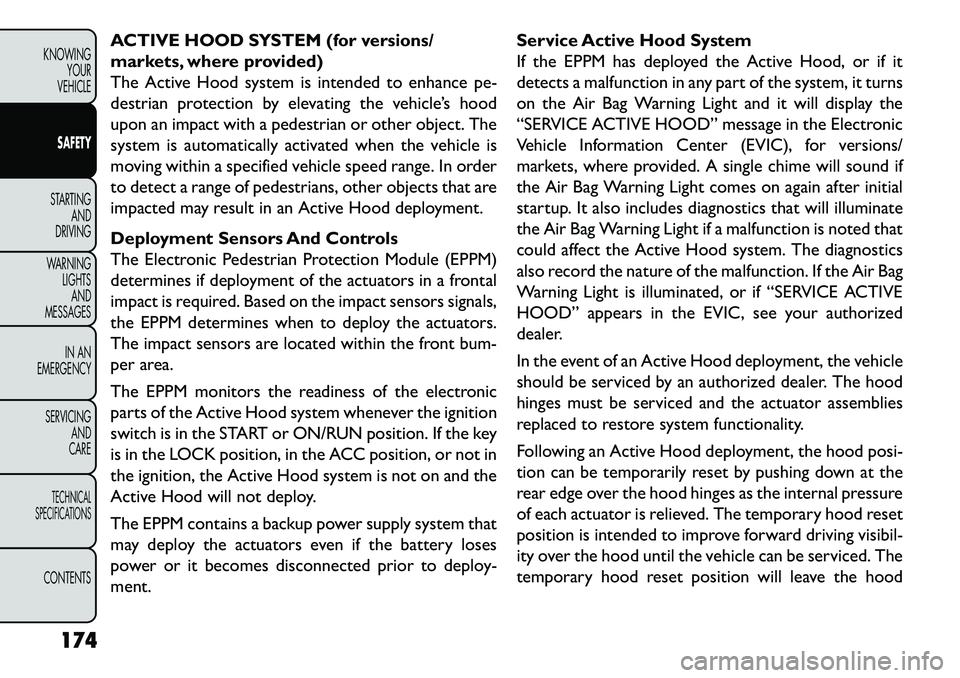
ACTIVE HOOD SYSTEM (for versions/
markets, where provided)
The Active Hood system is intended to enhance pe-
destrian protection by elevating the vehicle’s hood
upon an impact with a pedestrian or other object. The
system is automatically activated when the vehicle is
moving within a specified vehicle speed range. In order
to detect a range of pedestrians, other objects that are
impacted may result in an Active Hood deployment.
Deployment Sensors And Controls
The Electronic Pedestrian Protection Module (EPPM)
determines if deployment of the actuators in a frontal
impact is required. Based on the impact sensors signals,
the EPPM determines when to deploy the actuators.
The impact sensors are located within the front bum-
per area.
The EPPM monitors the readiness of the electronic
parts of the Active Hood system whenever the ignition
switch is in the START or ON/RUN position. If the key
is in the LOCK position, in the ACC position, or not in
the ignition, the Active Hood system is not on and the
Active Hood will not deploy.
The EPPM contains a backup power supply system that
may deploy the actuators even if the battery loses
power or it becomes disconnected prior to deploy-
ment.Service Active Hood System
If the EPPM has deployed the Active Hood, or if it
detects a malfunction in any part of the system, it turns
on the Air Bag Warning Light and it will display the
“SERVICE ACTIVE HOOD” message in the Electronic
Vehicle Information Center (EVIC), for versions/
markets, where provided. A single chime will sound if
the Air Bag Warning Light comes on again after initial
startup. It also includes diagnostics that will illuminate
the Air Bag Warning Light if a malfunction is noted that
could affect the Active Hood system. The diagnostics
also record the nature of the malfunction. If the Air Bag
Warning Light is illuminated, or if “SERVICE ACTIVE
HOOD” appears in the EVIC, see your authorized
dealer.
In the event of an Active Hood deployment, the vehicle
should be serviced by an authorized dealer. The hood
hinges must be serviced and the actuator assemblies
replaced to restore system functionality.
Following an Active Hood deployment, the hood posi-
tion can be temporarily reset by pushing down at the
rear edge over the hood hinges as the internal pressure
of each actuator is relieved. The temporary hood reset
position is intended to improve forward driving visibil-
ity over the hood until the vehicle can be serviced. The
temporary hood reset position will leave the hood
174
KNOWING YOUR
VEHICLE
SAFETY
STARTING AND
DRIVING
W
ARNING LIGHTS AND
MESSAGES
IN AN
EMERGENCY
SERVICING AND
CARETECHNICAL
SPECIFICATIONSCONTENTS
Page 181 of 352
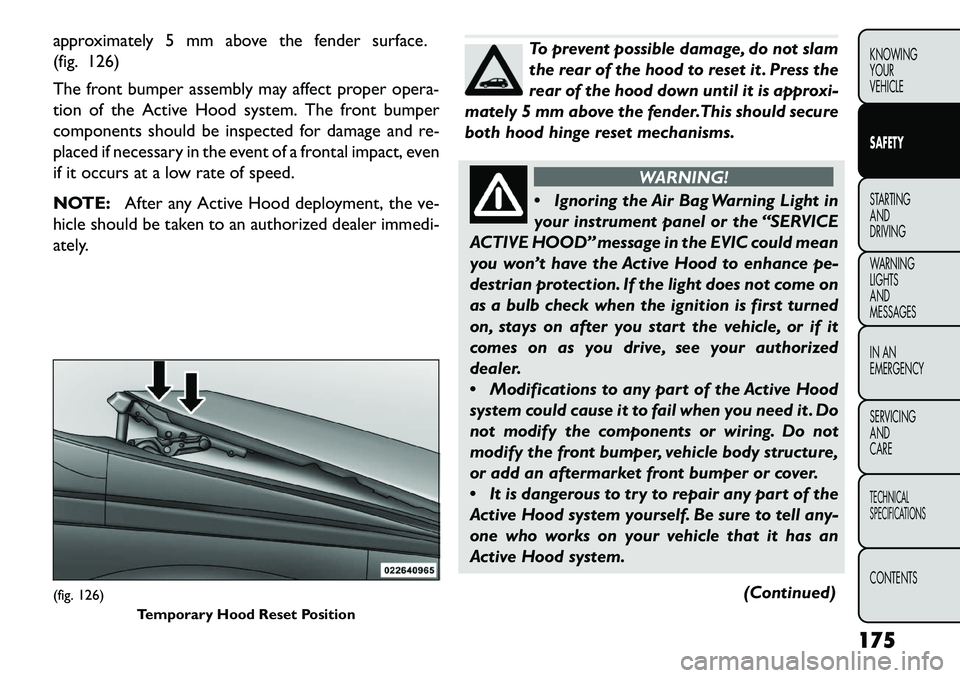
approximately 5 mm above the fender surface.
(fig. 126)
The front bumper assembly may affect proper opera-
tion of the Active Hood system. The front bumper
components should be inspected for damage and re-
placed if necessary in the event of a frontal impact, even
if it occurs at a low rate of speed.
NOTE:After any Active Hood deployment, the ve-
hicle should be taken to an authorized dealer immedi-
ately.
To prevent possible damage, do not slam
the rear of the hood to reset it . Press the
rear of the hood down until it is approxi-
mately 5 mm above the fender.This should secure
both hood hinge reset mechanisms.
WARNING!
Ign
oring the Air Bag Warning Light in
your instrument panel or the “SERVICE
ACTIVE HOOD” message in the EVIC could mean
you won’t have the Active Hood to enhance pe-
destrian protection. If the light does not come on
as a bulb check when the ignition is first turned
on, stays on after you start the vehicle, or if it
comes on as you drive, see your authorized
dealer.
Modifications to any part of the Active Hood
system could cause it to fail when you need it . Do
not modify the components or wiring. Do not
modify the front bumper, vehicle body structure,
or add an aftermarket front bumper or cover.
It is dangerous to try to repair any part of the
Active Hood system yourself. Be sure to tell any-
one who works on your vehicle that it has an
Active Hood system.
(Continued)
(fig. 126)Temporary Hood Reset Position
175
KNOWING
YOUR
VEHICLE
SAFETY
STARTING
AND
DRIVING
W
ARNING
LIGHTS
AND
MESSAGES
IN AN
EMERGENCY
SERVICING
AND
CARETECHNICAL
SPECIFICATIONSCONTENTS
Page 182 of 352
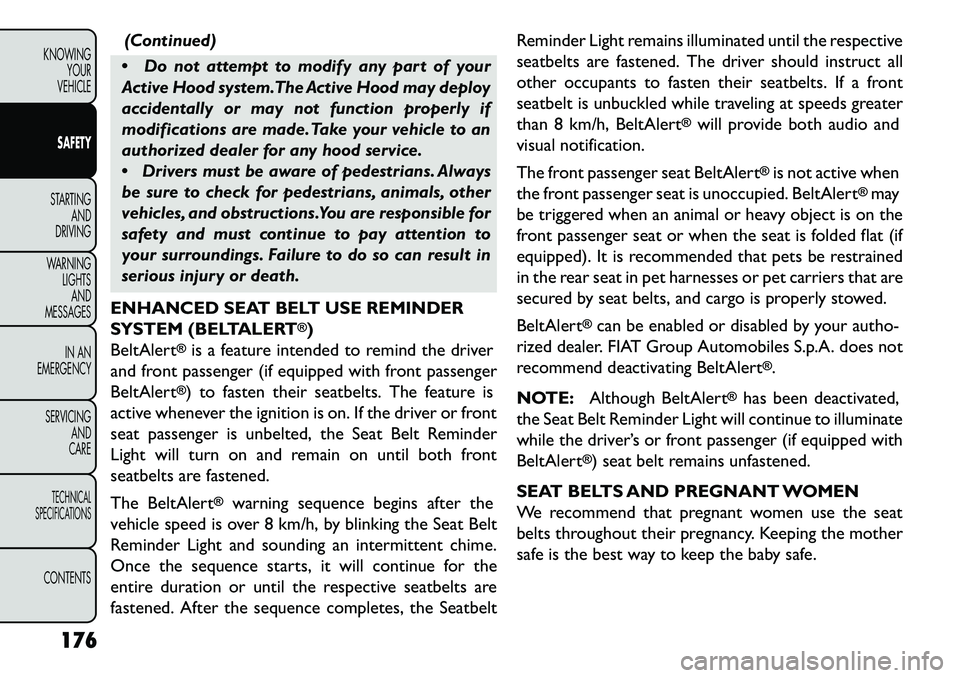
(Continued)
Do not attempt to modify any part of your
Active Hood system.The Active Hood may deploy
accidentally or may not function properly if
modifications are made. Take your vehicle to an
authorized dealer for any hood service.
Drivers must be aware of pedestrians. Always
be sure to check for pedestrians, animals, other
vehicles, and obstructions.You are responsible for
safety and must continue to pay attention to
your surroundings. Failure to do so can result in
serious injury or death.
ENHANCED SEAT BELT USE REMINDER
SYSTEM (BELTALERT
®)
BeltAlert
®is a feature intended to remind the driver
and front passenger (if equipped with front passenger
BeltAlert®) to fasten their seatbelts. The feature is
active whenever the ignition is on. If the driver or front
seat passenger is unbelted, the Seat Belt Reminder
Light will turn on and remain on until both front
seatbelts are fastened.
The BeltAlert
®
warning sequence begins after the
vehicle speed is over 8 km/h, by blinking the Seat Belt
Reminder Light and sounding an intermittent chime.
Once the sequence starts, it will continue for the
entire duration or until the respective seatbelts are
fastened. After the sequence completes, the Seatbelt Reminder Light remains illuminated until the respective
seatbelts are fastened. The driver should instruct all
other occupants to fasten their seatbelts. If a front
seatbelt is unbuckled while traveling at speeds greater
than 8 km/h, BeltAlert
®will provide both audio and
visual notification.
The front passenger seat BeltAlert
®is not active when
the front passenger seat is unoccupied. BeltAlert
®may
be triggered when an animal or heavy object is on the
front passenger seat or when the seat is folded flat (if
equipped). It is recommended that pets be restrained
in the rear seat in pet harnesses or pet carriers that are
secured by seat belts, and cargo is properly stowed.
BeltAlert
®can be enabled or disabled by your autho-
rized dealer. FIAT Group Automobiles S.p.A. does not
recommend deactivating BeltAlert
®.
NOTE: Although BeltAlert
®has been deactivated,
the Seat Belt Reminder Light will continue to illuminate
while the driver’s or front passenger (if equipped with
BeltAlert
®) seat belt remains unfastened.
SEAT BELTS AND PREGNANT WOMEN
We recommend that pregnant women use the seat
belts throughout their pregnancy. Keeping the mother
safe is the best way to keep the baby safe.
176
KNOWING YOUR
VEHICLE
SAFETY
STARTING AND
DRIVING
W
ARNING LIGHTS AND
MESSAGES
IN AN
EMERGENCY
SERVICING AND
CARETECHNICAL
SPECIFICATIONSCONTENTS
Page 183 of 352

Pregnant women should wear the lap part of the belt
across the thighs and as snug across the hips as pos-
sible. Keep the belt low so that it does not come across
the abdomen. That way the strong bones of the hips
will take the force if there is a collision.
CHILD RESTRAINTS
Everyone in your vehicle needs to be buckled up all the
time, including babies and children.
Children 12 years or younger should ride properly
buckled up in a rear seat, if available. According to crash
statistics, children are safer when properly restrained
in the rear seats rather than in the front.(fig. 127)
WARNING!
“E
xtreme Hazard! Do not use a
rearward-facing child restraint on a seat
protected by an air bag in front of it!” Refer to
visor and door shut face mounted labels for infor-
mation.
In a collision, an unrestrained child, even a tiny
baby, can become a projectile inside the vehicle.
The force required to hold even an infant on your
lap could become so great that you could not
hold the child, no matter how strong you are.The
child and others could be badly injured. Any child
riding in your vehicle should be in a proper re-
straint for the child's size.
(fig. 127)
177
KNOWING
YOUR
VEHICLE
SAFETY
STARTING
AND
DRIVING
W
ARNING
LIGHTS
AND
MESSAGES
IN AN
EMERGENCY
SERVICING
AND
CARETECHNICAL
SPECIFICATIONSCONTENTS
Page 185 of 352
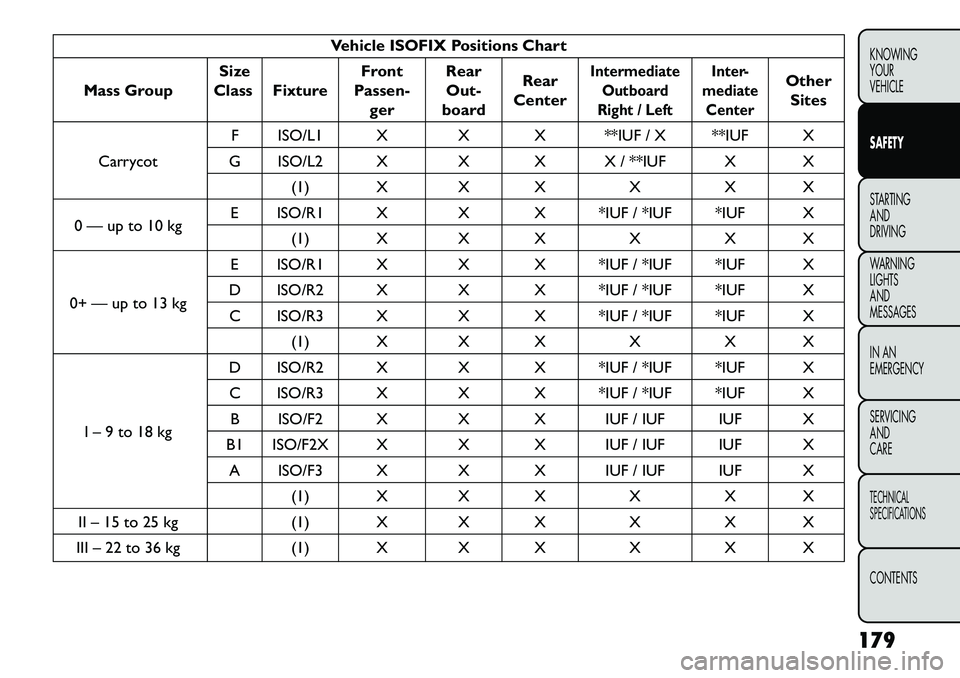
Vehicle ISOFIX Positions Chart
Mass Group Size
Class Fixture Front
Passen- ger Rear
Out-
board Rear
Center
Intermediate Outboard
Right / Left Inter-
mediate Center
Other Sites
Carrycot F ISO/L1 X X X **IUF / X **IUF X
G ISO/L2 X X X X / **IUF X X (1) X X X X X X
0 — up to 10 kg E ISO/R1 X X X *IUF / *IUF *IUF X
(1) X X X X X X
0+ — up to 13 kg E ISO/R1 X X X *IUF / *IUF *IUF X
D ISO/R2 X X X *IUF / *IUF *IUF X C ISO/R3 X X X *IUF / *IUF *IUF X (1) X X X XX X
I – 9 to 18 kg D ISO/R2 X X X *IUF / *IUF *IUF X
C ISO/R3 X X X *IUF / *IUF *IUF X B ISO/F2 X X X IUF / IUF IUF X
B1 ISO/F2X X X X IUF / IUF IUF X A ISO/F3 X X X IUF / IUF IUF X (1) X X X XX X
II – 15 to 25 kg (1) X X X XX X
III – 22 to 36 kg (1) X X X XX X
179
KNOWING
YOUR
VEHICLE
SAFETY
STARTING
AND
DRIVING
WARNING
LIGHTS
AND
MESSAGES
IN AN
EMERGENCY
SERVICING
AND
CARETECHNICAL
SPECIFICATIONSCONTENTS
Page 187 of 352

WARNING!
Rearward-facing child seats must never
be
used in the front seat of a vehicle with
the front passenger air bag. An air bag deploy-
ment could cause severe injury or death to in-
fants in this position.
Older Children And Child Restraints
Children who are two years old or who have outgrown
their rear-facing convertible child seat can ride
forward-facing in the vehicle. Forward-facing child
seats and convertible child seats used in the forward-
facing direction are for children who are over two years
old or who have outgrown the rear-facing weight or
height limit of their rear-facing convertible child seat.
Children should remain in a forward-facing child seat
with a harness for as long as possible, up to the highest
weight or height allowed by the child seat. These child
seats are also held in the vehicle by the lap/shoulder
belt or the ISOFIX child restraint anchorage system.
Refer to “ISOFIX — Child Seat Anchorage System”. All children whose weight or height is above the
forward-facing limit for the child seat should use a
belt-positioning booster seat until the vehicle’s seat
belts fit properly. If the child cannot sit with knees bent
over the vehicle's seat cushion while the child's back is
against the seatback, they should use a belt-positioning
booster seat. The child and belt-positioning booster
seat are held in the vehicle by the lap/shoulder belt.
Integrated Child Booster Seat (for
versions/markets, where provided)
The Integrated Child Booster Seat is located in each
outboard second-row passenger seat.
NOTE:
Refer to the Integrated Child Booster Seat
information label located on the front lower panel of
the opened Booster Seat for child weight specifica-
tions.
To position a child into the Integrated Child Booster
Seat follow these steps:
1. Slide the second row seat to the full rear position to use the Integrated Child Booster Seat.
NOTE: The second row bench with Integrated Child
Booster Seat must remain in the full rear position
during use.
181
KNOWING
YOUR
VEHICLE
SAFETY
STARTING
AND
DRIVING
WARNING
LIGHTS
AND
MESSAGES
IN AN
EMERGENCY
SERVICING
AND
CARETECHNICAL
SPECIFICATIONSCONTENTS
Page 189 of 352
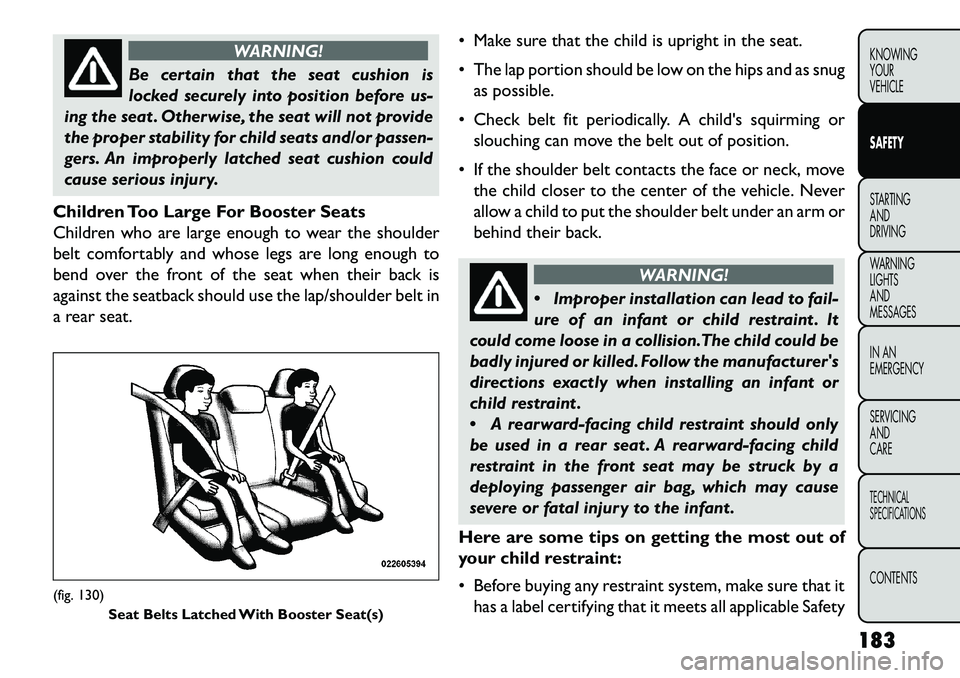
WARNING!
Be certain that the seat cushion is
lock
ed securely into position before us-
ing the seat . Otherwise, the seat will not provide
the proper stability for child seats and/or passen-
gers. An improperly latched seat cushion could
cause serious injury.
Children Too Large For Booster Seats
Children who are large enough to wear the shoulder
belt comfortably and whose legs are long enough to
bend over the front of the seat when their back is
against the seatback should use the lap/shoulder belt in
a rear seat. Make sure that the child is upright in the seat.
The lap portion should be low on the hips and as snug
as possible.
Check belt fit periodically. A child's squirming or slouching can move the belt out of position.
If the shoulder belt contacts the face or neck, move the child closer to the center of the vehicle. Never
allow a child to put the shoulder belt under an arm or
behind their back.
WARNING!
Impro
per installation can lead to fail-
ure of an infant or child restraint . It
could come loose in a collision.The child could be
badly injured or killed. Follow the manufacturer's
directions exactly when installing an infant or
child restraint .
A rearward-facing child restraint should only
be used in a rear seat . A rearward-facing child
restraint in the front seat may be struck by a
deploying passenger air bag, which may cause
severe or fatal injury to the infant .
Here are some tips on getting the most out of
your child restraint:
Before buying any restraint system, make sure that it has a label certifying that it meets all applicable Safety
(fig. 130) Seat Belts Latched With Booster Seat(s)
183
KNOWING
YOUR
VEHICLE
SAFETY
STARTING
AND
DRIVING
W
ARNING
LIGHTS
AND
MESSAGES
IN AN
EMERGENCY
SERVICING
AND
CARETECHNICAL
SPECIFICATIONSCONTENTS
Page 190 of 352

Standards. FIAT also recommends that you make
sure that you can install the child restraint in the
vehicle where you will use it before you buy it.
The restraint must be appropriate for your child's weight and height. Check the label on the restraint
for weight and height limits.
Carefully follow the instructions that come with the restraint. If you install the restraint improperly, it may
not work when you need it.
Buckle the child into the seat according to the child restraint manufacturer's directions.
WARNING!
When your child restraint is not in use,
s
ecure it in the vehicle with the seat belt
or remove it from the vehicle. Do not leave it
loose in the vehicle. In a sudden stop or collision,
it could strike the occupants or seatbacks and
cause serious personal injury.
ISOFIX — Child Seat Anchorage System
Your vehicle's second row passenger seats are
equipped with the child restraint anchorage system
called ISOFIX. The ISOFIX system provides for the
installation of the child restraint without using the
vehicle's seat belts, instead securing the child restraint using lower anchorages and upper tether straps from
the child restraint to the vehicle structure.
ISOFIX-compatible child restraint systems are now
available. However, because the lower anchorages are
to be introduced over a period of years, child restraint
systems having attachments for those anchorages will
continue to have features for installation using the
vehicle's seat belts. Child restraints having tether straps
and hooks for connection to the top tether anchorages
have been available for some time. For some older child
restraints, many child restraint manufacturers offer
add-on tether strap kits or retrofit kits. You are urged
to take advantage of all the available attachments pro-
vided with your child restraint in any vehicle.
All three second-row passenger seating positions have
lower anchorages that are capable of accommodating
ISOFIX-compatible child seats. You should never install
ISOFIX-compatible child seats so that two seats share
a common lower anchorage. If installing child seats in
adjacent seating positions, or if your child restraints are
not ISOFIX-compatible, install the restraints using the
vehicle's seat belts. (fig. 131)
184
KNOWING YOUR
VEHICLE
SAFETY
STARTING AND
DRIVING
W
ARNING LIGHTS AND
MESSAGES
IN AN
EMERGENCY
SERVICING AND
CARETECHNICAL
SPECIFICATIONSCONTENTS
Page 193 of 352
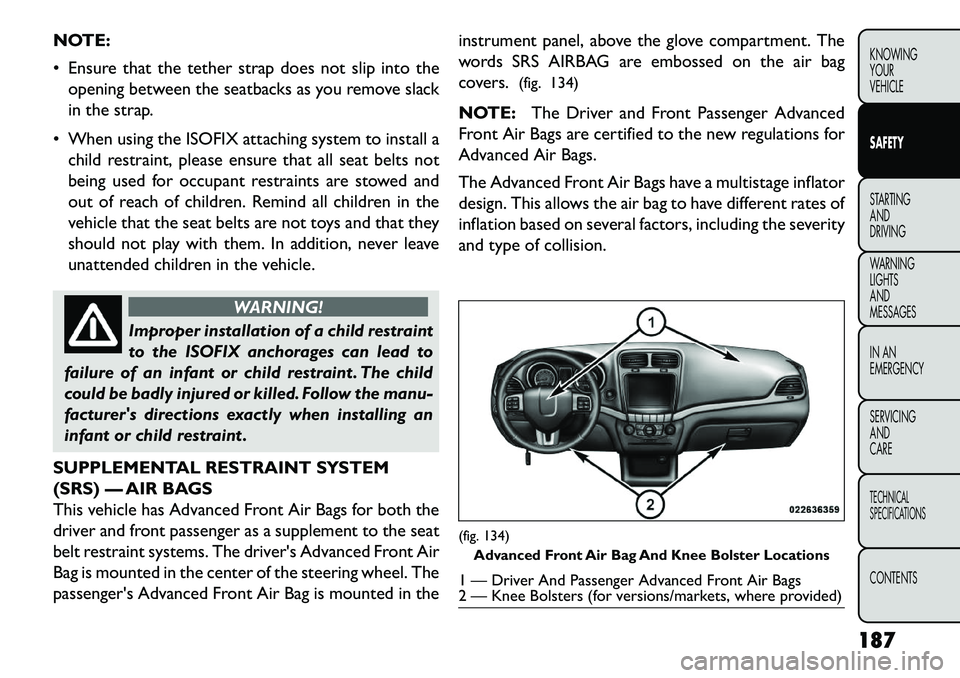
NOTE:
Ensure that the tether strap does not slip into theopening between the seatbacks as you remove slack
in the strap.
When using the ISOFIX attaching system to install a child restraint, please ensure that all seat belts not
being used for occupant restraints are stowed and
out of reach of children. Remind all children in the
vehicle that the seat belts are not toys and that they
should not play with them. In addition, never leave
unattended children in the vehicle.
WARNING!
Improper installation of a child restraint
t
o the ISOFIX anchorages can lead to
failure of an infant or child restraint . The child
could be badly injured or killed. Follow the manu-
facturer's directions exactly when installing an
infant or child restraint .
SUPPLEMENTAL RESTRAINT SYSTEM
(SRS) — AIR BAGS
This vehicle has Advanced Front Air Bags for both the
driver and front passenger as a supplement to the seat
belt restraint systems. The driver's Advanced Front Air
Bag is mounted in the center of the steering wheel. The
passenger's Advanced Front Air Bag is mounted in the instrument panel, above the glove compartment. The
words SRS AIRBAG are embossed on the air bag
covers.
(fig. 134)
NOTE: The Driver and Front Passenger Advanced
Front Air Bags are certified to the new regulations for
Advanced Air Bags.
The Advanced Front Air Bags have a multistage inflator
design. This allows the air bag to have different rates of
inflation based on several factors, including the severity
and type of collision.
(fig. 134) Advanced Front Air Bag And Knee Bolster Locations1 — Driver And Passenger Advanced Front Air Bags
2 — Knee Bolsters (for versions/markets, where provided)
187
KNOWING
YOUR
VEHICLE
SAFETY
STARTING
AND
DRIVING
W
ARNING
LIGHTS
AND
MESSAGES
IN AN
EMERGENCY
SERVICING
AND
CARETECHNICAL
SPECIFICATIONSCONTENTS
Page 194 of 352
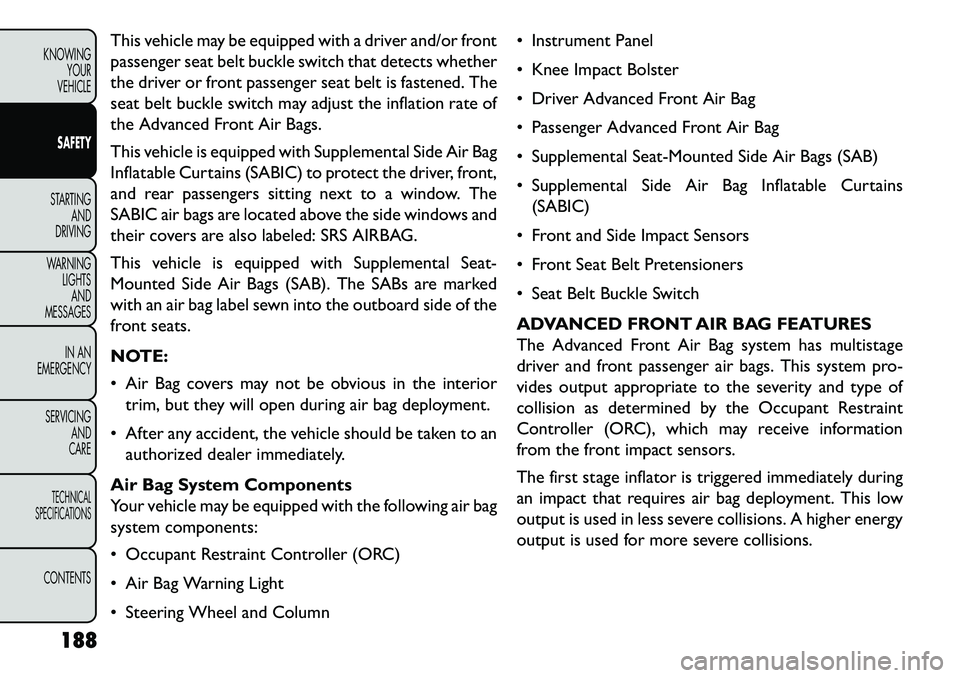
This vehicle may be equipped with a driver and/or front
passenger seat belt buckle switch that detects whether
the driver or front passenger seat belt is fastened. The
seat belt buckle switch may adjust the inflation rate of
the Advanced Front Air Bags.
This vehicle is equipped with Supplemental Side Air Bag
Inflatable Curtains (SABIC) to protect the driver, front,
and rear passengers sitting next to a window. The
SABIC air bags are located above the side windows and
their covers are also labeled: SRS AIRBAG.
This vehicle is equipped with Supplemental Seat-
Mounted Side Air Bags (SAB). The SABs are marked
with an air bag label sewn into the outboard side of the
front seats.
NOTE:
Air Bag covers may not be obvious in the interiortrim, but they will open during air bag deployment.
After any accident, the vehicle should be taken to an authorized dealer immediately.
Air Bag System Components
Your vehicle may be equipped with the following air bag
system components:
Occupant Restraint Controller (ORC)
Air Bag Warning Light
Steering Wheel and Column Instrument Panel
Knee Impact Bolster
Driver Advanced Front Air Bag
Passenger Advanced Front Air Bag
Supplemental Seat-Mounted Side Air Bags (SAB)
Supplemental Side Air Bag Inflatable Curtains
(SABIC)
Front and Side Impact Sensors
Front Seat Belt Pretensioners
Seat Belt Buckle Switch
ADVANCED FRONT AIR BAG FEATURES
The Advanced Front Air Bag system has multistage
driver and front passenger air bags. This system pro-
vides output appropriate to the severity and type of
collision as determined by the Occupant Restraint
Controller (ORC), which may receive information
from the front impact sensors.
The first stage inflator is triggered immediately during
an impact that requires air bag deployment. This low
output is used in less severe collisions. A higher energy
output is used for more severe collisions.
188
KNOWING YOUR
VEHICLE
SAFETY
STARTING AND
DRIVING
W
ARNING LIGHTS AND
MESSAGES
IN AN
EMERGENCY
SERVICING AND
CARETECHNICAL
SPECIFICATIONSCONTENTS